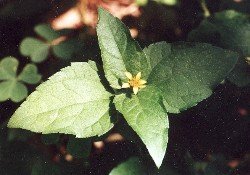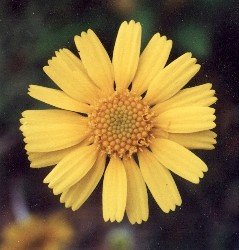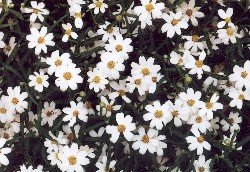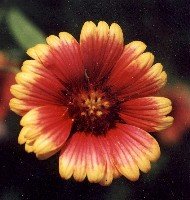|
A previous article covered three other species in Daisies. Since writing that piece, I've photographed more of the flowers in this huge family so it's time for a sequel.
 Although I am hesitant to label any plant a "weed," there is one that comes about as close as it can. Straggler daisy (Calyptocarpus vialis) grows absolutely everywhere in our yard and gardens. Referred to as sprawling horseweed, horseherb, and prostrate lawn flower, this naturalized import from Central America is probably the most successful plant in this area. It can grow anywhere, from sun to shade, needs little water, spreads rapidly, and weathers the winter freezes with no ill effects. It is not a particularly attractive plant, either. The flowers are tiny and often misshapen, and the leaves form a scrubby clump. When the plant freezes, the leaves die and remain as dry, brown litter on the stiff stems and must be cut back to allow for new growth in the spring. Besides propagating by seed, straggler daisy spreads by means of runners and a single clump invariably has many roots, making it difficult to remove. Besides its drawbacks, the plant does make a suitable ground cover, especially for dry shade and rock-hard clay soil. I often use it as temporary greenery until I want to clear a bit for another kind of plant.
Although I am hesitant to label any plant a "weed," there is one that comes about as close as it can. Straggler daisy (Calyptocarpus vialis) grows absolutely everywhere in our yard and gardens. Referred to as sprawling horseweed, horseherb, and prostrate lawn flower, this naturalized import from Central America is probably the most successful plant in this area. It can grow anywhere, from sun to shade, needs little water, spreads rapidly, and weathers the winter freezes with no ill effects. It is not a particularly attractive plant, either. The flowers are tiny and often misshapen, and the leaves form a scrubby clump. When the plant freezes, the leaves die and remain as dry, brown litter on the stiff stems and must be cut back to allow for new growth in the spring. Besides propagating by seed, straggler daisy spreads by means of runners and a single clump invariably has many roots, making it difficult to remove. Besides its drawbacks, the plant does make a suitable ground cover, especially for dry shade and rock-hard clay soil. I often use it as temporary greenery until I want to clear a bit for another kind of plant.
 The other daisies discussed here are more attractive and are all natives. Four-nerve daisy (Hymenoxys scaposa) can only grow in one place in our yard. It requires full sun and dry conditions, but does admirably when given the right place. This flower is a member of the bitterweed group and is sometimes called slender-stem bitterweed. It is also called plains yellow daisy. Our plants started from seed, but only one has thrived, as the short stature of the daisy makes it easy for it to become overgrown by taller, more aggressive plants. The leaves are very thin and stiff, and are a dusty gray-green color. The flowers grow on the ends of long, straight stems that emerge from the clump of leaves. As the plant grows, it forms a thick stem close to the ground that is almost woody. The leaves do not freeze back in the winter. An interesting phenomenon about the blossoms is the way the petals remain on the stem. When they are spent, they don't drop off, but curl back under the central disk and dry up.
The other daisies discussed here are more attractive and are all natives. Four-nerve daisy (Hymenoxys scaposa) can only grow in one place in our yard. It requires full sun and dry conditions, but does admirably when given the right place. This flower is a member of the bitterweed group and is sometimes called slender-stem bitterweed. It is also called plains yellow daisy. Our plants started from seed, but only one has thrived, as the short stature of the daisy makes it easy for it to become overgrown by taller, more aggressive plants. The leaves are very thin and stiff, and are a dusty gray-green color. The flowers grow on the ends of long, straight stems that emerge from the clump of leaves. As the plant grows, it forms a thick stem close to the ground that is almost woody. The leaves do not freeze back in the winter. An interesting phenomenon about the blossoms is the way the petals remain on the stem. When they are spent, they don't drop off, but curl back under the central disk and dry up.
 Another sun-loving plant is the black-footed daisy (Melampodium leucanthum). Also called rock daisy, plains black-foot, arnica, and mountain daisy, this plant can grow in the rockiest of soil. It forms a small clump of stiff, hairy leaves, and produces a lot of flowers. It almost looks like a bouquet set on the ground. While I'm not usually all that fond of white flowers, this plant has won me over with its long bloom period and profusion of blossoms.
Another sun-loving plant is the black-footed daisy (Melampodium leucanthum). Also called rock daisy, plains black-foot, arnica, and mountain daisy, this plant can grow in the rockiest of soil. It forms a small clump of stiff, hairy leaves, and produces a lot of flowers. It almost looks like a bouquet set on the ground. While I'm not usually all that fond of white flowers, this plant has won me over with its long bloom period and profusion of blossoms.
 At the other end of the color spectrum, painted daisy (Gaillardia pulchella) is one of the most colorful of our wildflowers. It often grows in huge fields, which look orange from a distance as the yellow and red blend together. This annual is also called blanketflower, Indian blanket, gaillardia, and firewheel. There are related gaillardias which are perennial, but the one seen in this area most frequently is one of the few annuals. It does best in sun, and when conditions are just right, the germination rate of the seeds is high. It even blooms in the shade of our gardens, but does not grow very large. Collecting seeds is a prickly business as the seed head, when dry, has very sharp points sticking out. Painted daisy blooms in the spring, but dies by the time the weather gets hot and dry.
At the other end of the color spectrum, painted daisy (Gaillardia pulchella) is one of the most colorful of our wildflowers. It often grows in huge fields, which look orange from a distance as the yellow and red blend together. This annual is also called blanketflower, Indian blanket, gaillardia, and firewheel. There are related gaillardias which are perennial, but the one seen in this area most frequently is one of the few annuals. It does best in sun, and when conditions are just right, the germination rate of the seeds is high. It even blooms in the shade of our gardens, but does not grow very large. Collecting seeds is a prickly business as the seed head, when dry, has very sharp points sticking out. Painted daisy blooms in the spring, but dies by the time the weather gets hot and dry.
|